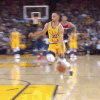Los Soles wrote:The metric may be simple, but BASKETBALL is complicated. That's the whole point. This is a massive, crucial philosophical divide. I think that it is extremely unlikely that either of us can convince the other or that we can find a comfortable middle road. I fundamentally disagree with you about our ability to accurately measure all the subtleties of defense directly. I'm not sure, however, what concerns you have with RAPM/APM.
My concerns with RAPM/APM is that it's an engineer's attempt to understand basketball. There's a lot of "noise" in however you do the adjustments, no matter how many years background there is to it. You're ultimately taking an indirect metric and subjecting it to a series of formulas, and there's only so much you can get from that.
Direct data is to be preferred, I think. And it's not that difficult to scorekeep a game with PDSS metrics. I've coached and officiated the game for years after I stopped playing, it's not that tricky. And, frankly, when you have PDSS data you have
what actually happened. The game was watched, the results were tabulated - and it's reliable. My eyes probably weren't tricked, and God knows I spent way too much time to be deceitful or be deceived (thank God for PVRs).
But the divide in the numbers is enormous. We only have the Raptors to look at, but take a look at the difference among bigs.
2009-2010 PDSS DRat:
Amir 109.5
Bargs 110.0
Bosh 110.0
Multi-year RAPM:
Amir +3.3
Bargs -4.2
Bosh +2.3
Your stats have these guys as essentially equivalent, while RAPM says that Amir and Bosh are both very good defenders and that Bargs is the worst defender in the league. The one-year RAPM for 2009-2010 also has Bargs as the worst defender in the league. These are incredibly consistent with the fact that Bargs' increase in minutes has correlated with the plummeting defensive rating of the Raptors overall to the worst defensive team in the league two years running, as well as the fact that in simple net rating the team has been 7.41, 9.10, and 6.45 points better defensively per 100 possessions when he is on the bench for the past three seasons. He has also been among the three worst players league-wide in overall defensive rating (basketballvalue.com) for the past two years (115.87 and 115.17), topping the list in 2009-2010. RAPM gets more accurate with a greater accumulation of data, and every single year Bargs' defensive value has fallen further as the numbers have become clearer.
It was what it was. That one year, Bargnani actually played as hard as he ever has on the defensive end of the floor. He had to handle switches on every ball screen when Calderon was on the floor, he did a good job contesting on the perimeter, he did a decent job around the basket while too many other players did...nothing. Calderon was particularly horrendous; I'm sure you noticed his stop% was around the same level that uncontested action (i.e. "thin air") was. You'll also notice a distinct improvement in the team's performance in those games in which he didn't play. I believe the improvement was somewhere around 5 points / 100 possessions in those games.
Now, if you look at the 2010/11 data, you see Bargnani performing at a level which we more or less expect from him. Why? He didn't give a damn last year after about the first 10 games. I'm not saying Bargnani has ever been a good defender (he really hasn't, and the PDSS data showed that in a "good" year for him, he was still at a DRat of 110), but there are levels to his performance.
So maybe PDSS data has something to communicate. Maybe APM can only give you so much. I think in issues of doubt, direct data is to be preferred over indirect data, no? And just because APM indicates one thing, you can't go and ignore all data to the contrary. It might be helpful to question APMs results, too.
Bargs certainly doesn't get all the credit for the Raptors' horrendous defense, but essentially saying that he's the same caliber defender as Amir and Bosh is completely ludicrous. He is a terrible defender.
Was the same thing indicated in 2010-11?
Perhaps more careful analysis than "well, I don't like the results, so I'll toss them away" is needed.


















